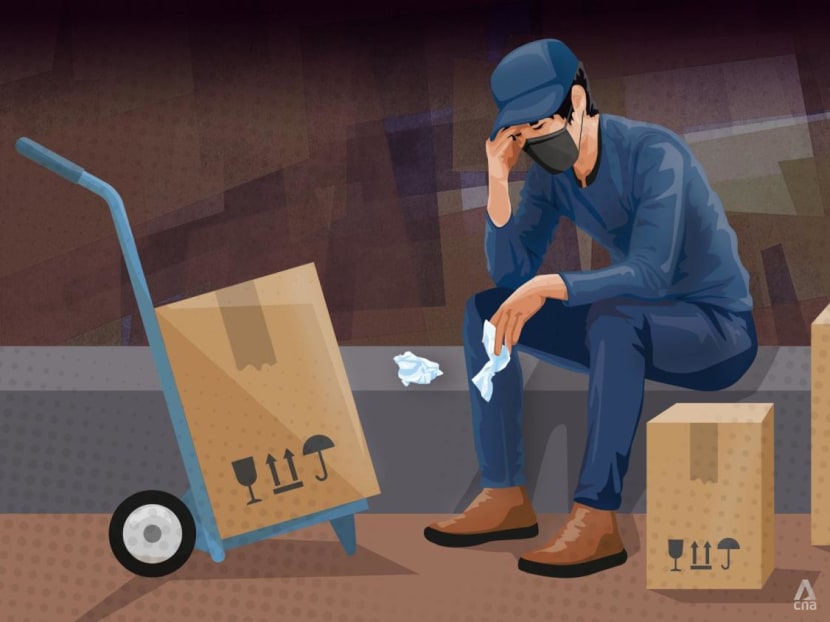Go to work sick or take a day off and forfeit a bonus? It's not as clear cut as it seems, say employees

(Illustration: Rafa Estrada)
SINGAPORE: Joshua (not his real name), has not taken a day of medical leave since he joined his company seven months ago.
Just a week before this interview, he had a slight cough and flu symptoms. After taking an antigen rapid test and getting a negative result, he decided to go to work all the same.
A prime mover driver, Joshua works an 8pm to 8am shift on weekdays and earns a base pay of S$48 a night. Although he is entitled to 14 days of annual leave and another 14 days of medical leave, he has not used any of them.
If he works a minimum of 22 days each month, he gets an incentive of S$650 per month. From his 20th day of work each month, he also gets an additional S$100 per day.
His pay increases to S$120 per day if all the possible incentives are included. With two young children to feed, Joshua needs the money.
“I never once took leave before because of the incentive. We only take S$48 for basic per day ... for 24 workdays (adds up to) only S$1,000 plus. The S$650 is almost more than half our basic pay, so definitely people who are sick seldom take any MC (medical certificate),” he told CNA.
“Especially at the month-end ... if you fall sick and don’t come to work, there’s a direct penalty straight away. Your hard work at the start will be gone.”
Joshua’s experience is not unique. Incentives for workers who do not take medical leave made the news earlier in January after a pest control technician was jailed for refusing a COVID-19 swab test because he did not want to forfeit a S$100 work incentive from his company.
The 60-year-old man, A Rahim M Taha, had a cough for three weeks and was told by a doctor to take a swab test and stay home. But he went to work the next day and went on job calls at five locations.
The court heard that Rahim earned a basic salary of S$1,500 a month at a pest control company. If he fulfilled certain conditions, including not taking any medical leave during the month, he would be given an additional S$100 allowance.
“The no-MC incentive is designed with the view of two prongs. One prong is to make sure that employees adhere to a healthy lifestyle so as to minimise their sick MCs,” said executive director of the Singapore Human Resources Institute Mr Alvin Goh.
“But really the intention is really to look at reducing operational issues, and also to deter errant employees from fully utilising their MCs when they’re really not sick.”
These incentives also tend to be common in shift work or for lower-wage workers, experts CNA spoke to said.
This is especially so for technical jobs and operational jobs that “really require the employees to be at the workplace at the appropriate time” because backups are “very limited”, said Mr Goh.
Workers in these jobs tend to be difficult to replace on short notice, said Dr Sherwin Ignatius Chia, a senior lecturer with the S R Nathan School of Human Development at the Singapore University of Social Sciences (SUSS).
They also tend to be more common in smaller companies, because it is a “very simple and easy way” to reward these workers, he added.
“Under manpower law, employees are entitled to sick leave if you work for more than three months. So if you’re trying to tell them or incentivise them not to use them … you’re not treading on any legal boundaries, but the approach doesn’t seem appropriate,” said Dr Chia.
Falling sick is something that employees cannot control, he stressed.
“If you’re truly unwell, be it physically and psychologically, then to penalise these individuals for something that’s beyond their control … What can you do? You force me to not take any MC.”
The Ministry of Manpower (MOM) did not respond to CNA’s queries about their stand on no-medical leave incentives, how common they are across industries, and whether there are any laws governing the implementation of such attendance policies.
The National Trade Union Congress (NTUC) also declined to respond to similar queries.
To meet the requirements for such incentives despite falling sick, some employees resort to workarounds.
When Joey (not his real name) worked as an assistant manager in a restaurant from 2016 to 2017, he would use his annual leave entitlement to cover his absence when he fell ill, instead of taking medical leave.
If he did not take any medical leave for the whole year, he would get a bonus of S$1,000 at the end of the year, he said, adding that this was spelt out in his job offer letter. This was about 30 per cent of his monthly pay.
The incentive was removed a few years later, and the restaurant has since folded. Joey managed to qualify for the incentive while working there, one of the two people who managed to do so out of about 100 employees, he shared with CNA.
“It’s an F&B thing, you cannot afford to have people take MC on a Friday, weekends. It may work for a few people who really want the money, but not everybody can be so tough,” Joey said.
In his time with the company, he used his annual leave entitlement when he fell ill about two or three times. Like Joshua, he also had standard annual leave and medical leave entitlements.
“In F&B we also never really clear finish our leave. So why not just clear leave and don’t take the MC, and since the bonus is there, (just) use it,” Joey said.
“I would say it’s (the policy) to encourage people not to take MC. Not discourage, from the employer’s point of view. But for the employees, you feel like you want the dollars. You don’t want to take MC.”
For Joey’s wife, who works full-time at a laundry company, getting penalised for taking medical leave is still a reality today.
Her base pay is around S$1,800, with an additional allowance of S$200. Each time she takes a sick day, S$50 is deducted from the allowance, up to a maximum of S$150.
DIFFERENT POLICIES
Companies CNA spoke to were mixed in their implementation of similar policies.
A spokesperson for DFI Retail Group, which manages the Giant and Cold Storage supermarkets, said the group does not have a no-medical leave incentive.
“Our team members are given time off to go for their booster shots and recuperate as needed, and we have a strict policy mandating that sick employees should not return to work until they have fully recovered to ensure everyone’s safety,” the spokesperson said.
Security agency Soverus does not have a no-medical leave incentive for its security officers, said its managing director Kelvin Goh.
“We believe that medical leave is an entitlement for the officers. We do not want to have officers who are unwell to come back to work, because they want to get the no-MC incentive,” he told CNA.
Adding that a no-medical leave incentive is “not a necessity”, Mr Goh said that operational issues due to last-minute MCs can be mitigated by having a small pool of standby officers for each shift.
“While this may cause an increase in cost, we feel that it is still better than to have a sick officer who is unable to perform his duties properly at work,” he added.
“Of course, if the number of officers exceeds the number of standby officers that we have, we end up with a shortage of manpower for that shift and have to explain to the clients.”
Instead of a no-medical leave incentive, Soverus gives incentives based on punctuality, not taking unpaid leave and no complaints from clients or members of the public, said Mr Goh. He declined to comment on whether no-medical leave incentives are common in the security industry.
The security agency also has a reward system for officers who receive commendations from clients or members of the public. There is a quarterly bonus or incentives pegged to a quarter of the officers’ salaries, he added.
But at pest control agency PestBusters, no-medical leave incentives have been in place since “day one in 1991”, said its human capital manager Steffi Choon. She did not provide details about how the incentive works, and how much it is worth.
The incentives are in place to increase productivity and ensure workers are rewarded for their hard work, she added. “These are role models for others to emulate.”
So far, the incentive is “working very well” and the company’s human resources team ensures that employees “understand why this no-MC is an added bonus to them”, said Ms Choon.
Despite the incentives, employees do not ignore their health or COVID-19 measures to come to work, she said.
“We do have two days (where staff can) call in sick with no MC to be produced. We encourage all staff to see a doctor if they are not feeling well. This is to protect co-workers and their families,” said Ms Choon.
If an employee continues to work despite not feeling well, they will be counselled and persuaded to rest “as we treasure each staff”, she added.
Other companies have more lenient policies or adjusted their no-medical leave incentives with COVID-19.
At compressor company Aerzen Asia, the average number of sick days taken among all employees will act as the “threshold” each year. Anyone who has fewer than the average – typically around three days – will qualify for a reward, said its managing director Chuck Lim.
The company allocates S$200 worth of supermarket vouchers for each of its 20 employees. The vouchers for those who did not qualify for the rewards would be split among those who did.
The scheme encouraged “MC kings and queens” who used to take medical leave “as and when they like” not to do so anymore, said Mr Lim.
Of 20 employees, 17 qualified for the reward this year, he said.
“It’s not about taking MCs if you’re sick. If you’re sick, of course you’re sick. But they tend to keep themselves healthier, and it is a bit of recognition,” he said, adding that the rewards are typically given out before Chinese New Year.
"I’ve considered increasing the incentive, but I don’t want to run afoul of what’s happening, in the sense that if they have the flu they come to work and they spread it, that’s going to be the worst situation. I don’t want that,” he said.
“I’m trying to strike a balance where they are incentivised but at the same time not being overly zealous in trying to get the reward.”
Other companies in the industry do have zero-MC policies, said Mr Lim, adding that he does employ engineers and technicians that are difficult to replace when they go on medical leave.
“That’s how I came up with the idea. Zero is … you may as well don’t give (incentives). I don’t want people if they’re sick, they have a fever and they come to work. They’re running machinery and that is dangerous. I don’t want that, so I give them some leeway, cut them some slack."
MAKING WAY FOR MORE FLEXIBILITY
Experts agreed that such incentives should not be too rigid.
No-medical leave policies may not be sustainable or translate into long-term commitment because employees cannot consistently achieve zero-MCs for four to five years, said SUSS lecturer Dr Chia.
“With this kind of policies, one of the biggest issues that I see is that you’re creating a norm … If you’re truly sick or just (have) mild symptoms, you actually mask the symptoms and come to work because I want to get that bonus. You’re actually increasing the risk of spreading infectious diseases in your company.”
This breeds a work culture where employees may value a monetary bonus over their own health and safety or that of their colleagues, he said.
Such policies may also mask the real reasons why employees take medical leave when they do not need it. For example, absenteeism could be due to poor leadership, the work environment or being overworked, said Dr Chia.
“If people are just avoiding work because they don’t find work meaningful, or they find work stressful, or they find that they’re not appreciated or they’re fatigued, then you can have this policy but you’re not resolving the actual problem at work,” he added.
Incentive policies should adapt to different situations and be applied to different age groups, especially in Singapore, which is moving towards a multi-generational workforce, said SHRI’s Mr Goh.
“A lot of these policies were designed in a pre-COVID world. In a post-COVID world, if we really think about it whereby the emphasis is on social and personal responsibility, then you’re driving a very wrong behaviour if you still continue to dangle a carrot, or this incentive,” he added.
With more people resigning from their jobs around the world “fed up because of all these rigid policies”, these policies have a “finite shelf life” with changes in social norms, said Mr Goh.
“If we really look at the current climate, there must be a new people construct in terms of how you’re going to lead the workforce today and tomorrow. If you think that you as a business leader could lead your organisation with an authoritative top-down approach, I think you’re on the wrong path.”








